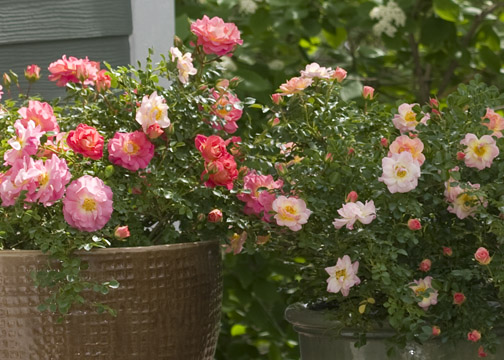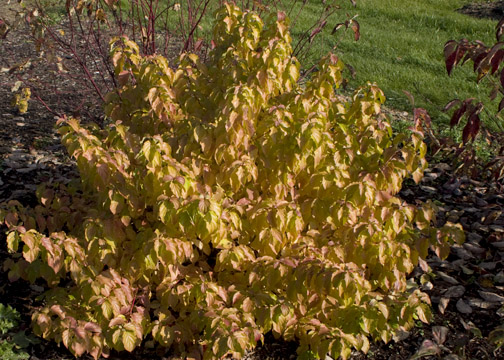It’s easy to find new plants. What’s hard is finding better plants. When I hunt for new plants it’s easy to get overly excited. I have to show some discipline, otherwise, I’ll end up with lots of plants that are interesting for collectors, but useless for gardeners.
 |
Good gardens should based on form and foliage, and not just flowers.
|
Some years back I heard J. C. Raulston lamenting that no one wanted to grow all the cool plants he collected and distributed. He examined the problem and then developed a list attributes that he felt made a plant a successful. This prompted me to develop my own list. My list gives me the discipline I spoke of earlier. I also use it shape and guide our Proven Winners shrub program. The vision I have for this program goes beyond novelty or new. My goal is to reinvent flowering shrubs; to change the way people perceive and use flowering shrubs; to make them more useful. My plant selection criterion helps to keep this vision on track. So my next few posts will examine some of the attributes I consider important when hunting out new selections. Today we’ll examine the importance of foliage.
Plants with Attractive Foliage
Shrubs and perennials typically flower for three to six weeks. Sure there are exceptions, but flowers are fleeting and foliage is not. A lesson I learned when grew and sold perennials is that they sell great when they’re in bloom. But after they’ve finished flowering - no one wants to buy them. This was not the case for perennials with interesting foliage. I could sell Hosta, Heuchera, Artemesia, Festuca, Japanese Ferms (Athyrium nipponicum 'Pictum) and Variegated Iris (Iris pallida 'Variegata') all season long.
As a landscape designer I learned that the most interesting gardens were those based on form and foliage, and not the flowers. Flowers should be considered as icing on the cake, not the cake itself. Attractive foliage, be it colorful, variegated, textured, fall color, or glossy can make a garden attractive even when it’s not in bloom. These plants are good for the garden centers because they extend the selling season. And they’re good for gardeners and landscapers because they make for interesting gardens.
This is a powerful, yet largely untapped, goal for plant breeders. Consider daylilies (Hemerocallis), which has more plant breeding activity than any other species. Sure it’s a glorious plant in bloom, but when the flowers are spent it is one of the saddest of all plants. At one point in my life I managed a daylily collection that contained over 500 cultivars; many of them award winners. Once the flowers were gone the collection was an ugly mess. But if you looked closely, you would discover that, while most of the plants turned yellow and collapsed to the ground, a few stood tall and remained deep green. Look even closer and you would find a few plants with bluish leaves or glossy foliage. So why can’t these plants have better foliage?
Clearly, foliage alone will never be as sexy as a flower, but can’t we have both? I think we can. Here is just a small sampling of shrubs that give you both the icing and the cake.









I'm sold! I often seem to find plants whose flowers I like, but not their foliage...and sometimes, vice-versa.
ReplyDeleteAmen! I'm forever counseling my clientele that foliage is the workhorse of any landscape design; the flowers might even be a negative, depending on just how "maintenance-averse" the owner is. You've picked a few of my faves here… I also rely heavily on Coleonema 'Sunset Gold,' Euphorbia 'Helena's Blush,' Physocarpus 'Center Glow,' Spirea 'Goldflame,' and almost any colored Berberis or Heuchera.
ReplyDeleteAs a self-described foliage freak, I totally loved this post. SPOT ON!
ReplyDeleteWhile you're out hunting, there is a Jerusalem Sage that is variegated (Phlomis russeliana 'Mosaic') but only found in Europe. PLEASE find this awesome plant and bring her here to the US for us to love! I'd love to have more low-water perennials with colorful foliage. Lots of shrubs fit that bill but it's tougher with perennials.
Seeing the foliage of my 'Gold Mops' through the kitchen window has helped get me through the winter -- although, with the snows we've had this winter, only the top of the shrub is visible! Thanks for the lovely photos: Viewing them takes me a step closer to spring (in my mind).
ReplyDeleteOn the black lace elder berry, does it have the same fragile stem problems as native elderberry,
ReplyDeleteand does it set fruit as much as native elder berry?
Lastly if it does set fruit, is the wine made from it just as good as native Elderberry? Which I do enjoy. I may have to add this plant to my yard.
Black Lace is a European Elder - Sambucus nigra. The fruit is commonly grown and used for jams and wine. Planting two cultivars of the same species will increase the fruit production. This species flowers earlier than or native elder so it will not work as a pollinator.
ReplyDeleteFirst and foremost I would like to thank for posting this nice article about Gardening,
ReplyDeleteI’m a novice at this kind of field and planning to increase my knowledge about it.
I’m so glad that I’ve stumbled upon this post really helped me a lot,
Thanks again.
I just quoted you in a speech I'm working on about lessons I have learned in gardening. Flowers should be the icing on the cake, not the cake itself. Beautiful stuff. Thanks, man.
ReplyDeleteThanks for a good post but don't forget about late fall and winter interest - all of these plants are deciduous and spend quite a few months as bare tangles of branches. It would be great to see the trade promoting more evergreen shrubs or plants with interesting stems, bark and form to give the winter garden some eye appeal.
ReplyDelete